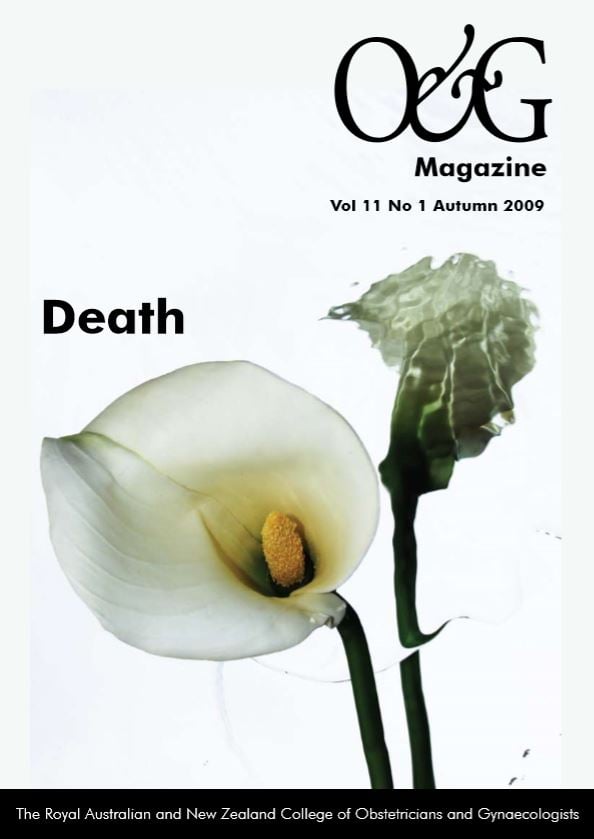‘Childbed fever’ – puerperal sepsis due to streptococcal infection introduced into the vagina by a woman’s birth attendants – was a common cause of death much feared by pregnant women until the end of the 19th century.
While fatal childbirth-related septicaemia is now extremely rare in current Australian practice, this is largely because of our armamentarium of powerful antibiotics. We would be wise to pay more attention, in the birth suites of the 21st century, to the basic principles of antisepsis and hygiene, elucidated by Semmelweis, Wendell Holmes, Lister and others in the 19th century.
Henry VIII had six wives but only one gave him a son. It was Lady Jane Seymour, the third wife, who fulfilled that most important duty for a queen of the times. However, she did not savour her triumph long, dying just 12 days after a prolonged labour and a difficult birth.
Jane was first noticed by the King while serving as lady-in-waiting to the ill-fated Anne Boleyn, who had provided only a daughter, the future Elizabeth I, for Henry. Within 24 hours of Anne’s execution, in May of 1536, Jane and Henry were formally betrothed, and were married four days later. (It was said that the puddings for the wedding feast were boiling even as Anne was led to the scaffold). Rumours of pregnancy began almost immediately, but it wasn’t until early 1537 that the rumours were confirmed as fact, and the news of Jane’s quickening celebrated throughout England. The Queen took to her chambers at Hampton Court in mid-September and began labour on 11 October. The following day, when she was still undelivered, her attending physicians asked Henry whether he wished the mother or the child to be saved. ‘If you cannot save both, at least let the child live,’ was Henry’s prompt reply, ‘for other wives are easily found.’
A few hours afterwards, Jane was safely delivered of a prince who was to have a short reign as Edward VI. The birth of his long-desired heir so excited the King that, overlooking the exhausted state of his Queen, he ordered the christening, in which Jane was required to take part, to be carried out within days. Jane, very weak, was wrapped in robes and carried to the prolonged ceremony on a litter. Only a day later, it was reported that she was gravely ill. She was delirious and had a high fever. Her doctors bled her but she never rallied and died 12 days postpartum from what was almost certainly puerperal sepsis, probably related to vaginal examinations performed by her physicians during her prolonged labour.
Puerperal sepsis has been recognised since ancient times as a killer of women following childbirth, the condition not heeding the social status of the mother. The writings of Hippocrates include references to childbed fever and there are even earlier references in some Hindu texts. It also seems that some of these ancient writers understood the potential for infection to be introduced by the birth attendants. The work of the Greek physician Soranus contains advice on cleanliness for midwives, as do the Hindu texts. It appears, though, that death from puerperal sepsis was relatively uncommon in ancient and medieval times, since women generally gave birth at home.
The 17th century saw the establishment of ‘lying-in’ hospitals throughout Europe, a development followed later in North America, Australia and New Zealand. These institutions were undoubtedly beneficial to some women in obstructed labour or with malpresentations, who could be delivered with forceps or by obstetric manipulations. However, overcrowding in dirty wards, as well as the complete lack of knowledge of the existence of bacteria and the need for antisepsis, meant that frequent vaginal examinations in labour and the use of unsterile instruments caused epidemics of puerperal sepsis throughout the ensuing two centuries. Between epidemics intermittent cases were common. It was well recognised among the medical profession and the public that the condition was peculiar to women giving birth: William Harvey wrote in 1651 that in postpartum women ‘…a suddaine gangrene doth induce a certain death’. Theories as to its causation were numerous and bizarre: that it was due to a ‘miasma’ circulating in the hospital, or to the troubled state of mind of the labouring woman, or to undue pressure of the uterus on the abdominal contents. The possibility of contagion as a cause was suspected by several doctors in Britain in the late 18th and early 19th centuries, among them Thomas Watson of King’s College London, and Alexander Gordon of Aberdeen, who noted similarities between puerperal fever and erisypelas. However, little attention was paid by the profession as a whole to these observations.
Credit for discovering the infectious nature of the condition and for instituting measures to prevent it, goes to two remarkable men, Oliver Wendell Holmes of Boston and Ignaz Semmelweis, a Hungarian practising in Vienna. The two men worked independently, neither aware of the other’s findings. Holmes’ attention to the condition began in the early 1840s when two fatal cases of septicaemia, in a doctor and a medical student, were presented to his Boston Society for Medical Improvement. The doctor and student had both attended an autopsy of a woman who had died from puerperal fever. Holmes read all he could lay his hands on about the condition and became convinced that doctors, nurses and midwives were the agents of its spread. In 1843, he published his important short paper, The Contagiousness of Puerperal Fever, which contained eight important rules for birth attendants, including such revolutionary advice as handwashing before attending a woman in labour and not going directly from the autopsy room to the bedside. He began to speak in public on the subject. For his pains, he was ridiculed by many of his colleagues. Prominent American obstetrician, Charles Meigs, was outraged at the suggestion that he might be infecting his own patients. ‘Doctors,’ he said, ‘are gentlemen and gentlemen’s hands are clean.’
At the same time, Semmelweis, assistant lecturer in the First Obstetric Division of the Vienna Lying-In Hospital, was developing what would become a life-long obsession with the disease. He was shocked by the high mortality rates among women giving birth in his division, which was where medical students undertook their obstetric training. In the years from 1841 to 1843, 16 per cent of all women giving birth at this hospital died from puerperal sepsis. In the Second Division, where midwives and midwifery students performed the deliveries, mortality from puerperal sepsis was only two per cent. Semmelweis observed that the medical students attended autopsies each morning before coming to his wards, whereas the midwives were not required to do so. However, it was only in 1847, when a pathologist colleague died of septicaemia, having accidentally sustained a cut to his hand during an autopsy, that Semmelweis made the connection between the soiled hands of students and doctors and the development of puerperal fever in women subsequently examined by them. Semmelweis established a system of cleaning hands for all those working in the First Division, using chlorate of lime solution, with remarkable success. In a six-month period in 1847, the death rate in the First Division plummeted from 18 per cent to two per cent of all women. Like Holmes, Semmelweis found scepticism and scorn among his colleagues. His contract in Vienna was not renewed and he returned to Hungary. He did not publish his findings and conclusions until 1861, when they were largely dismissed by the European medical establishment, and he died, depressed and bitter, in an asylum in 1865.
However, 1865 was also the year in which Joseph Lister began to apply principles of antisepsis to the practice of surgery in his wards in Edinburgh. Lister was impressed by the work of Louis Pasteur in France on the germ theory of disease. Insisting on scrupulous attention to hygiene during and following surgical procedures, Lister demonstrated a dramatic fall in death rates post-operatively. He too met disbelief and incredulity amongst many of his colleagues. ‘Listerism’ became a creed that doctors did or did not believe in, rather than a piece of scientific evidence. It took nearly 30 years for the profession as a whole to recognise the important truth of Lister’s work. By the beginning of the 20th century, however, the use of sterilised instruments and dressings and meticulous attention to antisepsis during procedures were accepted features of obstetric as well as surgical practice. The use of rubber gloves for surgery and obstetrics, introduced in 1890, was the idea of Johns Hopkins Hospital surgeon William Halsted, whose scrub nurse (whom he later married) complained about the dermatitis she suffered from scrubbing with phenol. Halsted too, initially faced opposition from surgeons who complained that the gloves interfered with their surgical competence.
Nevertheless, deaths from puerperal sepsis continued, although in much smaller numbers than during previous centuries. It seems that the principles of Listerism were not universally applied. A variety of organisms (normal inhabitants of the skin, vagina and bowel) were responsible, but that most feared was the Group A haemolytic streptococcus, undoubtedly the cause of most of the institutional epidemics of earlier years. In 1935, in Germany, Gerhard Domagk demonstrated the prevention of streptococcal septicaemia in mice using prontosil, a sulphonamide dye. A year later, Leonard Colebrook and Meave Kenny at Queen Charlotte’s Hospital in London reported in The Lancet their success in treating established puerperal sepsis using prontosil – the death rate dropped from 27 per cent of cases to eight per cent. Prontosil and other sulphonamides were followed by the introduction of penicillin in 1944, to which the streptococci causing puerperal sepsis remain sensitive.
The scourge of ‘childbirth fever’ epidemics has virtually disappeared from the maternity wards of developed countries. The maternal mortality rate in Australia has fallen from around 600 per 100,000 births in the year 1900 to 10 to 12 per 100,000 today – about two-fifths of this drop can be attributed to the prevention of deaths from infection. It is worth noting, however, that powerful antibiotics of all kinds are widely used in current obstetric and midwifery practice. Antibiotic prophylaxis is an intrinsic part of every caesarean section and antibiotics are routinely used for prolonged rupture of the membranes, many operative vaginal deliveries, and in virtually any woman developing a fever postpartum. This dependence on antibiotics, and the fact that few of us practising today in developed countries have seen a woman die from puerperal sepsis, has tended sometimes to produce a relaxed attitude to antisepsis in the birth suite. The Group A haemolytic streptococcus has decreased in virulence, probably due to the use of antibiotics, but also due to the introduction of better public health measures. However, given that overuse of antibiotics has led to widespread resistance by many other bacterial strains, we would be well advised to pay more attention during childbirth to the principles of ‘Listerism’ in order to prevent a return to ‘the terror of the lying-in hospitals’.
References
- Jerrold W. Henry VIII and his wives. London: Hutchinson, 1926.
- Ricci JV. The genealogy of gynecology: history of the development of gynecology through the ages. Philadelphia: Blakiston, 1943.
- Hoyt EP. The Improper Bostonian: Dr Oliver Wendell Holmes. New York: William Morrow, 1979.
- Gortvay G, Zoltan I. Semmelweis – his life and work. Budapest: Akademiai Kiado, 1968.
- Lister J. The antiseptic system of treatment in surgery. Lancet 1870; 2:287.
- Loudon I. Deaths in childbed from the eighteenth century to 1935. Med History 1986; 30: 1-41.
- Colebrook L, Kenny M. Treatment of human puerperal infections, and of experimental infections in mice, with prontosil. Lancet 1936; 2: 1279-86.
- Donnay F. Maternal survival in developing countries: what has been done, what can be achieved in the next decade. Int J Gynaecol Obstet. 2000; 70(1): 89-97.






Leave a Reply